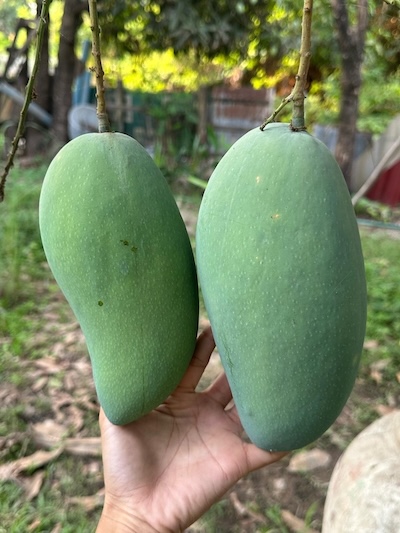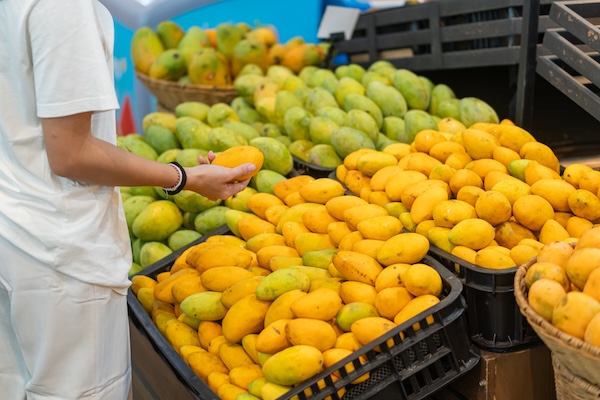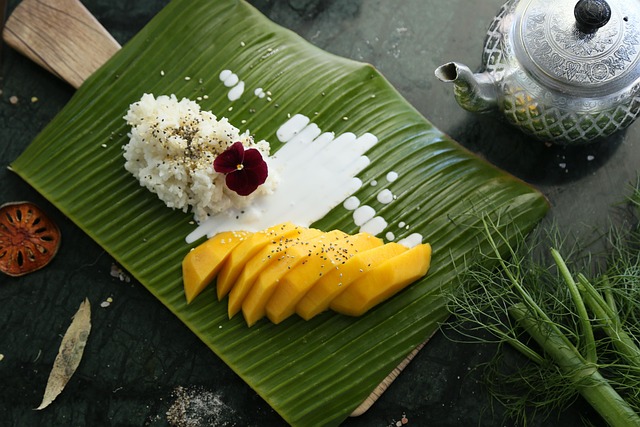What Makes Thai Mangoes Unique?

In Thailand, mangoes aren’t just another tropical fruit—they’re a cultural icon and everyday indulgence. Known locally as “mamuang”, these luscious fruits are found in nearly every market and home, whether in a quiet village or the bustling heart of Bangkok.
Thai mangoes are easily recognized by their thin skin and fragrant, buttery flesh. Depending on the type and ripeness, the flavor can range from sugar-sweet to brightly tangy. And yes, in Thai cuisine, mangoes are just as popular green and tart as they are golden and ripe.
One of the most surprising Thai street snacks? Slices of green mango dipped in a blend of salt, sugar, and crushed chili—a punchy mix of sour, sweet, and heat that’s surprisingly addictive.
Seasonality & Buying Tips
When’s the Best Time?
While you can find mangoes almost any time of year in Thailand, the peak season runs from March to June. During this period, markets overflow with ripe, affordable fruit.
Regions to Watch
Some of Thailand’s tastiest mangoes come from provinces like Ratchaburi, Phitsanulok, and Chachoengsao, where fertile land and warm climate create perfect growing conditions.

How to Choose a Good One
Need help picking the right mango?
- Smell the stem: A rich, sweet scent means it’s ready.
- Check the color: Varieties differ, but golden or lightly green skin is often ideal.
- Gently press: A slight give without mushiness signals ripeness.
Price Range & Seasonal Fluctuations
Mango prices vary by season and location. Expect to pay 20–40 baht per mango during harvest months, and a bit more off-season or in tourist zones.
Thai Mangoes in Daily Life and Culture
Mangoes in Thailand carry more than flavor—they carry meaning. Often featured in religious offerings and New Year blessings, they’re symbols of abundance, honor, and spiritual prosperity. During festivals, you’ll find them tucked into flower displays or gifted as tokens of appreciation.
For many Thai families, a mango tree in the backyard isn’t just decorative—it’s part of daily life. Children learn to climb its limbs, harvest the fruit, and prepare it in traditional recipes passed down from elders.
From Tree to Table

In Thailand, many mangoes are grown not in large plantations, but in backyards, family gardens, and small orchards. Seeing green mangoes hanging in clusters just outside the kitchen is a familiar scene across the countryside. These fruits often go straight from the tree to the table — no long supply chains, just freshness and tradition.
How Locals Eat Their Mangoes
Fresh and Juicy
Ripe mangoes are typically peeled and sliced, served chilled or at room temperature. This pure and simple preparation is how many Thai people enjoy them at home.
Green Mango with a Twist
Unripe mangoes offer a crisp bite and sour edge, balanced by dips made of salt, sugar, and spicy chili flakes. It’s a schoolyard favorite and street-food staple — and one of many delicious bites you’ll find in our Thai street snack guide.

Mango Sticky Rice & More
Thailand’s most iconic dessert is khao niew mamuang — sticky rice topped with sliced mango, coconut milk, and sesame seeds. Coconut milk plays a starring role in Thai desserts. To discover its culinary and cultural significance, check out our article on coconut in Thailand.
You’ll also find mangoes blended into smoothies or churned into refreshing sorbets.
Easy Recipes You Can Try
-
- Green Mango Salad: Combine shredded green mango with lime juice, palm sugar, fish sauce, peanuts, and dried shrimp.
- Mango Smoothie: Blend ripe mango with ice, coconut milk, and a hint of lime for a cool treat.
Health Benefits of Thai Mangoes
Rich in Nutrients
Thai mangoes are loaded with vitamin C, vitamin A, and powerful antioxidants that help fight cell damage and support your immune system. 👉 For more information, see this Healthline article on mango nutrition.
Good for Digestion
High in fiber, mangoes promote gut health and regularity. And with just around 60 calories per 100 grams, they’re a guilt-free snack packed with flavor.
More Tropical Fruits to Explore
If Thai mangoes have won your heart, you might also enjoy Thailand’s other iconic tropical fruits. Start with the durian, nicknamed the “king of fruits” for its bold aroma and custardy texture. Then discover the mangosteen, often called the “queen of fruits,” loved for its juicy, slightly tangy white flesh.
Nam Dok Mai (น้ำดอกไม้)
This elite variety is long and elegant, with melt-in-your-mouth sweetness and a floral aroma. It’s the go-to mango for sticky rice desserts across Thailand.
Ok Rong (อกร่อง)
Sweet, aromatic, and slightly fibrous, this nostalgic variety is loved for its old-school charm and balanced flavor.
Keo Savoy
Firm and tangy, Keo Savoy mangoes are a favorite for green mango salads and dipping with chili salt. They stay green even when mature.
Chok Anan
Available nearly year-round, Chok Anan is known for its honeyed taste and soft texture—great for smoothies or just eaten fresh.
Lesser-Known but Delicious
- Mahachanok – A hybrid mango with a reddish-yellow hue and intensely sweet, floral notes.
- Khieo Sawoei Sampran – Often eaten crunchy and green, especially popular in central Thailand.
Can You Bring Mangoes Home?
Fresh Mangoes: Usually Not Allowed
Most countries prohibit travelers from bringing fresh fruit due to biosecurity laws. Thai mangoes, though tempting, usually can’t be carried in your suitcase.
What You Can Bring Instead
- Dried mango (easy to find, long shelf life)
- Mango candies and fruit pastes
- Homemade jams and syrups
- Mango-scented beauty products
For more ideas on what to buy during your trip — from fashion finds to local crafts — check out our complete guide on shopping in Thailand.
Country-Specific Notes
- Australia: Allows fresh mangoes under specific certified conditions
- USA & Canada: Permitted if imported through approved programs
- EU: Generally restricts fresh imports; dried products are safe
👉 Always check your destination’s import rules before flying home with fruity souvenirs.
🔄 Last updated on May 4, 2025
